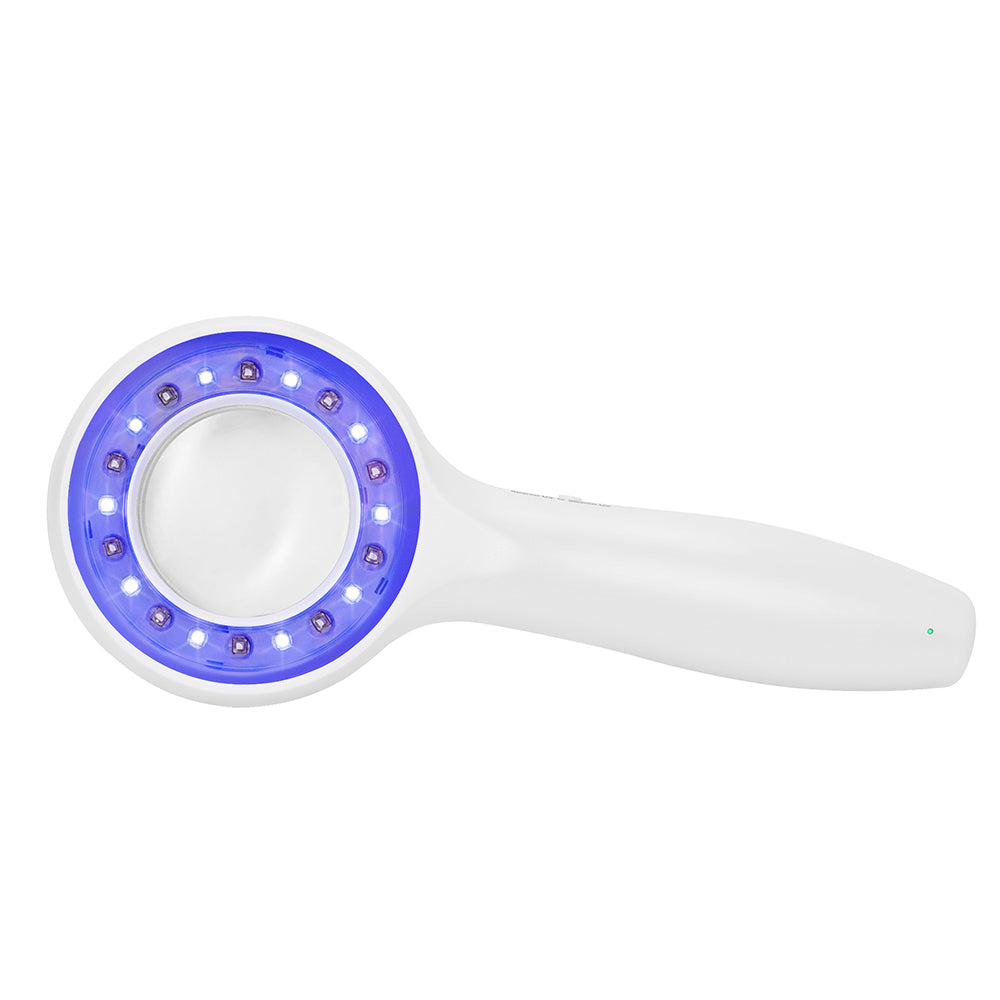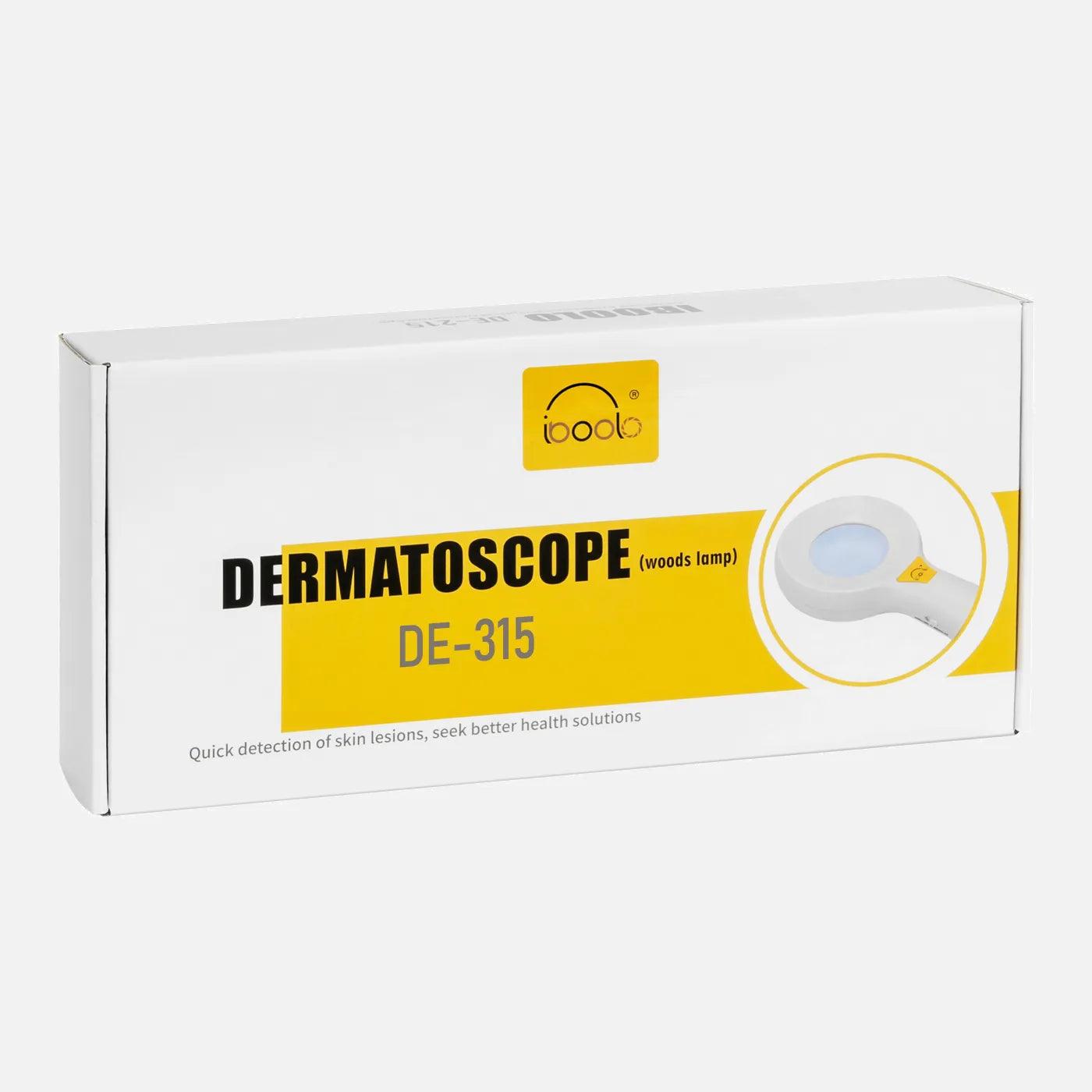SKU:DE-3153001
IBOOLO
IBOOLO Wood's Lamp DE-315 UV 365nm & UV405nm Violet Light For Veterinarian
IBOOLO Wood's Lamp DE-315 UV 365nm & UV405nm Violet Light For Veterinarian
Used by Dermatologist in 30+countries
FDA-Cleared CE Certified
Impossibile caricare la disponibilità di ritiro
Advantages of Wood's Lamp 315
• Ultra long-life battery 2000mAh

Technical Specification
| Name | Wood's Lamp |
| Item | DE-315 |
| Material | Optical and ABS |
| Magnification | 4.5 times |
| LEDS | 10 LEDS |
| Ultraviolet | 365nm and 405nm uv light |
| Warranty | 2 Years |
| Certification | CE FDA |
| Standard | ISO13485 ISO14001 |
| Battery | 2000mAh |
Woods Lamp DE-315 VISION
To effectively evaluate skin, excellent light and magnification are needed. The visual portion of diagnosis is based on distribution and morphology. 2 types of light source, 3 levels of brightness control, gives a lot choice to test under different situations.

60MM Lens
DE-315 woods lamp with the 60mm diameter. The big diameter designed to make sure there’s no missed corners and gaps, to present a super wide and clear visualization.

No Cross Contamination
The Wood lamp is turned on to warm up for about a minute. Room lights are turned off, and window shades are drawn, or black drape used to darken the surroundings completely. After waiting to adapt to the dark, the skin is examined with Wood lamp for a few seconds. The lamp is held about 10-30 cm away from the skin. The examination is painless and safe.
Iboolo DE-315 Woods Lamp: The Advanced UV Diagnostic Light for Dermatology and Beyond
As a leading dermatology lamp factory, Iboolo is proud to introduce the DE-315, a state-of-the-art Woods Lamp that redefines diagnostic capabilities in clinical and veterinary settings. Engineered with precision UV technology (365nm & 405nm), this versatile device is an essential tool for woods lamp dermatology, providing clinicians with unparalleled clarity for a wide spectrum of skin conditions. More than just a traditional wood lamp, the Iboolo DE-315 integrates advanced features that make it a compelling choice for professionals seeking reliable and high-performance diagnostic illumination.
For those requiring detailed visual documentation, our commitment as video woods lamp manufacturers ensures features that support comprehensive recording and analysis. Discover how the DE-315 can elevate your diagnostic practice.
The Indispensable Role of Woods Lamp in Dermatology
The Woods Lamp has long been a cornerstone in dermatology, offering a unique non-invasive method to diagnose and assess various skin, hair, and nail disorders. The Iboolo DE-315, with its optimized UV 365nm wavelength, is meticulously designed for precise woods lamp dermatology examinations. This specific wavelength allows for the characteristic fluorescence of certain skin pathogens and changes in pigmentation, which are often invisible under white light.
Key Applications in Human Dermatology:
- Fungal Infections: Identifies conditions like Tinea Capitis (scalp ringworm) by revealing a blue-green fluorescence, and Tinea Versicolor with a yellow-orange glow.
- Bacterial Infections: Detects Erythrasma with coral-red fluorescence, indicative of *Corynebacterium minutissimum*.
- Pigment Disorders: Clearly delineates the borders of vitiligo and assesses the epidermal or dermal depth of melasma, which fluoresces differently under the wood lamp.
- Porphyria: Helps diagnose conditions like Porphyria Cutanea Tarda by revealing pink-red fluorescence of urine.
- Acne: Highlights *P. acnes* bacteria within hair follicles, showing orange-red fluorescence, aiding in treatment assessment.
The Iboolo DE-315 ensures that every wood lamp dermatology examination is efficient, accurate, and provides critical insights for diagnosis and treatment planning.
Advanced Features for Enhanced Diagnostics: Beyond the Traditional Wood Lamp
The Iboolo DE-315 is not just an ordinary dermatology lamp; it represents the culmination of expertise from a specialized dermatology lamp factory. We've integrated features that enhance usability and diagnostic accuracy:
- Dual Wavelengths (UV 365nm & UV 405nm): The primary 365nm UV provides classic Woods Lamp diagnostics, while the additional 405nm UV offers further clarity for certain conditions, bridging the gap between traditional wood lamp and advanced UV illumination.
- Integrated Dermoscopy Capabilities: Our DE-315 product name includes "Dermoscopy Woods Lamp," signifying its ability to offer magnified views. While not a full dermatoscope in the traditional sense, this feature allows for closer examination of skin structures under UV light, an innovation derived from our continuous R&D as dermatology lamp manufacturers. This dual functionality offers a comprehensive assessment tool for professionals.
- High-Definition Optics: Experience crystal-clear visualization, ensuring that even subtle fluorescence patterns are easily discernible for precise woods lamp dermatology assessments.
This commitment to integrating multiple diagnostic modalities is what sets the Iboolo DE-315 apart in the market for dermatology lamp solutions.
Iboolo: Your Trusted Video Woods Lamp Manufacturers
In today's digital age, the ability to document and share diagnostic findings is paramount. Iboolo stands as a forward-thinking dermatology lamp factory, actively developing and producing medical devices that meet evolving professional demands. Our DE-315 Woods Lamp is designed with connectivity in mind, allowing for easy integration with external cameras or smartphone adapters for image capture. This makes us proud to be recognized as video woods lamp manufacturers.
The visual documentation capabilities provided by the Iboolo DE-315 enable:
- Patient Education: Show patients real-time images of their skin conditions and treatment progress.
- Remote Consultation: Share high-quality UV images with colleagues for second opinions or tele-dermatology.
- Clinical Record Keeping: Maintain accurate digital records for longitudinal studies and legal compliance.
- Teaching & Training: Utilize clear video Woods Lamp footage for educational purposes in medical schools and professional workshops.
Our goal as video woods lamp manufacturers is to empower dermatologists and veterinarians with tools that not only diagnose but also facilitate modern practice management and communication.
Why Choose Iboolo as Your Dermatology Lamp Factory?
Choosing Iboolo means partnering with a dermatology lamp factory that prioritizes quality, innovation, and reliability. With decades of experience in medical device manufacturing, we understand the stringent requirements of the healthcare industry. The Iboolo DE-315 is a prime example of our engineering excellence, built to serve the demanding field of woods lamp dermatology.
Our Commitment as a Dermatology Lamp Manufacturer:
- Rigorous Quality Control: Every dermatology lamp we produce undergoes strict testing to ensure consistent performance and safety.
- Innovative R&D: We continuously invest in research and development to bring cutting-edge diagnostic tools, including the next generation of video woods lamp technology, to the market.
- Global Standards: Our manufacturing processes adhere to international medical device standards and certifications.
- Customization & OEM/ODM Services: As a comprehensive dermatology lamp factory, we offer flexible solutions for distributors and partners worldwide.
- Dedicated Support: From pre-sales consultation to after-sales service, our team is committed to providing exceptional customer experience for all our dermatology lamp products.
Whether you are a clinic seeking a superior wood lamp for dermatology or a distributor looking for a reliable dermatology lamp factory, Iboolo offers the expertise and products you can trust.
Versatility Beyond Human Dermatology: Veterinary Applications
While optimized for woods lamp dermatology in human patients, the Iboolo DE-315's robust design and precise UV output also make it an invaluable tool for veterinary professionals. The ability to identify fungal infections (like dermatophytosis in cats and dogs) and other skin abnormalities in animals using the distinctive fluorescence under a wood lamp is crucial for early and accurate diagnosis in veterinary medicine. This dual-purpose functionality highlights the comprehensive utility derived from a focused dermatology lamp factory like Iboolo.
Invest in Precision Diagnostics with Iboolo DE-315 Woods Lamp
The Iboolo DE-315 Woods Lamp represents a significant advancement in diagnostic technology. Combining precise UV wavelengths, potential dermoscopic views, and the backing of a dedicated dermatology lamp factory, it is the ideal dermatology lamp for any clinic or professional committed to superior patient care. Upgrade your diagnostic capabilities with a wood lamp that delivers reliability and clarity for all your woods lamp dermatology and veterinary needs. Contact us today to learn more about our products and how we, as experienced video woods lamp manufacturers, can support your practice.

Package Include

- DE-315 Wood's Lamp
- Clean Cloth
- USB-C Cable
- English Version User Manaul
Share
















